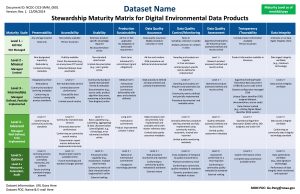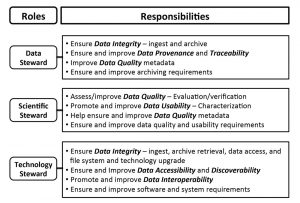Collecting, curating, and delivering accurate, reliable environmental data sets is a difficult task. But the work doesn’t stop there. Ensuring that data sets are adequately preserved and documented, and that they remain accessible and usable to end users, is an ongoing challenge.
In addition, the usefulness of these data sets also depends in large part on the ability of data providers and stewards to assess, demonstrate, and describe the quality of the information, and their ability to adopt community best practices and standards.
Dr. Ge Peng of NCICS and her colleagues from NOAA’s National Centers for Environmental Information are at the forefront of efforts to advance best practices and standards for the stewardship for environmental data.
Stewardship Maturity Matrix
 One recent outcome of these efforts was the development of a “stewardship maturity matrix”— a unified framework for assessing stewardship practices applied to individual digital climate data sets. The model specifies nine stewardship attributes and defines a five-level maturity scale for evaluating stewardship practices. This gives data stewards a road map for assessing and improving their data practices.
One recent outcome of these efforts was the development of a “stewardship maturity matrix”— a unified framework for assessing stewardship practices applied to individual digital climate data sets. The model specifies nine stewardship attributes and defines a five-level maturity scale for evaluating stewardship practices. This gives data stewards a road map for assessing and improving their data practices.
The resulting maturity matrix also allows data users to evaluate the appropriateness of a data set for their needs. The model is intended to be general enough to be used with a wide variety of digital environmental data products and a broad spectrum of users. Details are presented in a paper in Data Science Journal.
Roles and Responsibilities
 To help meet the challenges of the new era of Big Data and Open Data, Peng and her colleagues have also developed a framework of recommended roles, responsibilities, and skill sets for those tasked with stewarding critical environmental information resources.
To help meet the challenges of the new era of Big Data and Open Data, Peng and her colleagues have also developed a framework of recommended roles, responsibilities, and skill sets for those tasked with stewarding critical environmental information resources.
That framework, published in D-Lib Magazine, suggests that the responsibilities be distributed across three roles: data stewards, responsible for managing data sets and metadata; scientific stewards, responsible for managing the quality and usability of the data; and technology stewards, responsible for the necessary tools and systems. The paper also suggests skill sets, roles, and responsibilities for each role, and identifies high-level responsibilities for other stakeholders.
Publications
Peng, G., J. L. Privette, E. J. Kearns, N. A. Ritchey, and S. Ansari, 2015: A unified framework for measuring stewardship practices applied to digital environmental datasets. Data Science Journal, 13, 231-253. http://dx.doi.org/10.2481/dsj.14-049.
Peng, G., N. A. Ritchey, K. S. Casey, E. J. Kearns, J. L. Privette, D. Saunders, P. Jones, T. Maycock, and S. Ansari, 2016: Scientific stewardship in the Open Data and Big Data era – Roles and responsibilities of stewards and other major product stakeholders. D.-Lib Magazine, 22. http://dx.doi.org/10.1045/may2016-peng
